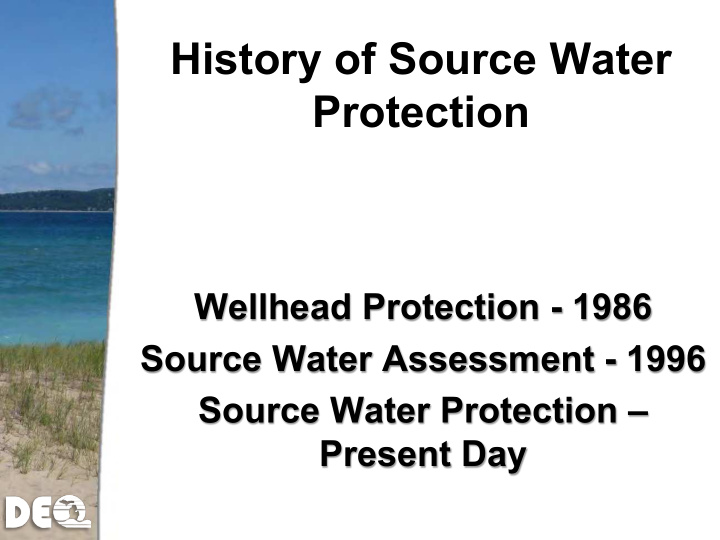



History of Source Water Protection Wellhead Protection - 1986 Source Water Assessment - 1996 Source Water Protection – Present Day
1986 Amendments to SDWA Several years effort by Congress to pass • amendments 1 st comprehensive set of amendments since • SDWA originally enacted Established the following: • New primary drinking water standards Expanded contaminant list from 23 to 83 Required EPA to publish “priority list” Established variance and exemption protocol Established two new groundwater programs Signed into law 6/19/1986 by President Reagan •
Two New Groundwater Programs Wellhead Protection - Required states develop • program to prevent contamination of groundwater supplying public water systems (Michigan made program voluntary for PWSSs) Critical Aquifer Protection – established a • grant program to assist state and local units of government in protecting “sole source aquifers” (Michigan chose to not participate)
At time of Enactment EPA estimated there were ~156,600 public • water supply systems 142,400 of the PWSSs relied on ground water 14,200 relied on surface water EPA estimated there were ~51,700 community • water systems 40,000 relied on ground water 11,700 relied on surface water The “fallacy” of these statistics? Majority of Michigan citizens served by relatively small number of surface water systems
Elements of Wellhead Protection • Roles and Duties State agency and local (utility) agency • Delineation of wellhead protection area “…surface and subsurface supplying water well or wellfield…” • Contaminant source inventory • Management approaches for WHPA Control measures to protect PWSS • Contingency planning (required by SDWA) • New Wells (Requirement to “plan ahead”) • Public participation (Community involvement )
Emphasis on water system management and • preventing contamination Placed focus on states to develop programs • related to: Source Water Protection - required states assess the “susceptibility” of PWSSs to contamination Capacity Development – emphasis on managerial and financial aspects Operator Certification – ensure knowledge and skill of PWSS operators
Source Water Protection Aim to reduce treatment cost and risks to • public health by protecting source water from contamination Players in Source Water Protection • Environmental Protection Agency Water Utilities Local communities / units of government States Businesses Citizens Integration of source water protection efforts to • ensure drinking water is protected
Federal Role in SWP • EPA worked to encourage partnerships State agencies Citizen groups Non-governmental agencies American Water Works Associations National Rural Water Association • Identified programs/tools for integration Clean Water Act and other EPA programs Agricultural programs Farm●A●Syst / Home●A●Syst Conservation Easements
State and Local Governments • Variety of state programs aid “source water protection” activities Wellhead protection programs Ground water management programs Watershed management programs • Similarly, local programs and efforts may contribute to efforts Local zoning to manage hazardous materials Zoning to protect land in “source water areas” Local management strategies Integration with land acquisition and/or conservation easements.
States required to submit program to EPA by • February of 1997 Program Elements • Delineate boundary of areas providing source water to PWSSs Identify regulated and certain unregulated contaminants in delineated areas Determine Susceptibility of PWSSs Michigan program approved Oct, 1999 •
Two year time frame for completion with • option for 18 month extension Directive to avoid duplication of efforts • Use sanitary survey process Integrate process with state WHPP, pesticide management plans, watershed initiatives, etc. Alternative monitoring requirements and • monitoring relief originally tied to source water assessment results
What is Source Water? Defined as untreated water from streams, • rivers, lakes or underground aquifers Water used to provide public drinking water • (and to supply private wells) States used various means of delineation Contributing Area Watershed Area
Michigan “Delineate” Approach Situation unique to Michigan • ~1,300 community water supplies ~11,000 non-community supplies Bulk of non-community systems in • Region V reside in two states vs Isolation Approach WHPA Approach
Identify Susceptibility Identify risks to PWSS Assign ranking: Low High
Source Water Assessments Michigan completed source water • assessments from 1998 to 2003 Period of completion coincident with sanitary • survey process Three year rotation on Type Is Five year rotation on Type IIs Consisted of scoring process and • “susceptibility” rating Basis of scoring process - isolation distances • Reports created and made available to • systems
Michigan’s Source Water Protection – Present Day Why are we here today? Reality Water system owners play a critical role in protecting source water Why Because protective actions must be tailored to local situations
Michigan’s Source Water Protection – Present Day cont’d Why are we here today? Source Water Assessment Updates Michigan one of few states in Region V to not update SWAs New Emphasis Emphasis on “wellhead protection area” as opposed to isolation distances
SWA New Approach Area contributing water to PWSS wells has • been defined using MGMT Emphasis on identifying potential sources of contamination that lie within the wellhead protection area Determine how SWA and susceptibility rating might have changed Use the results to better manage and reduce • potential sources of contamination to PWSS wells
Recommend
More recommend